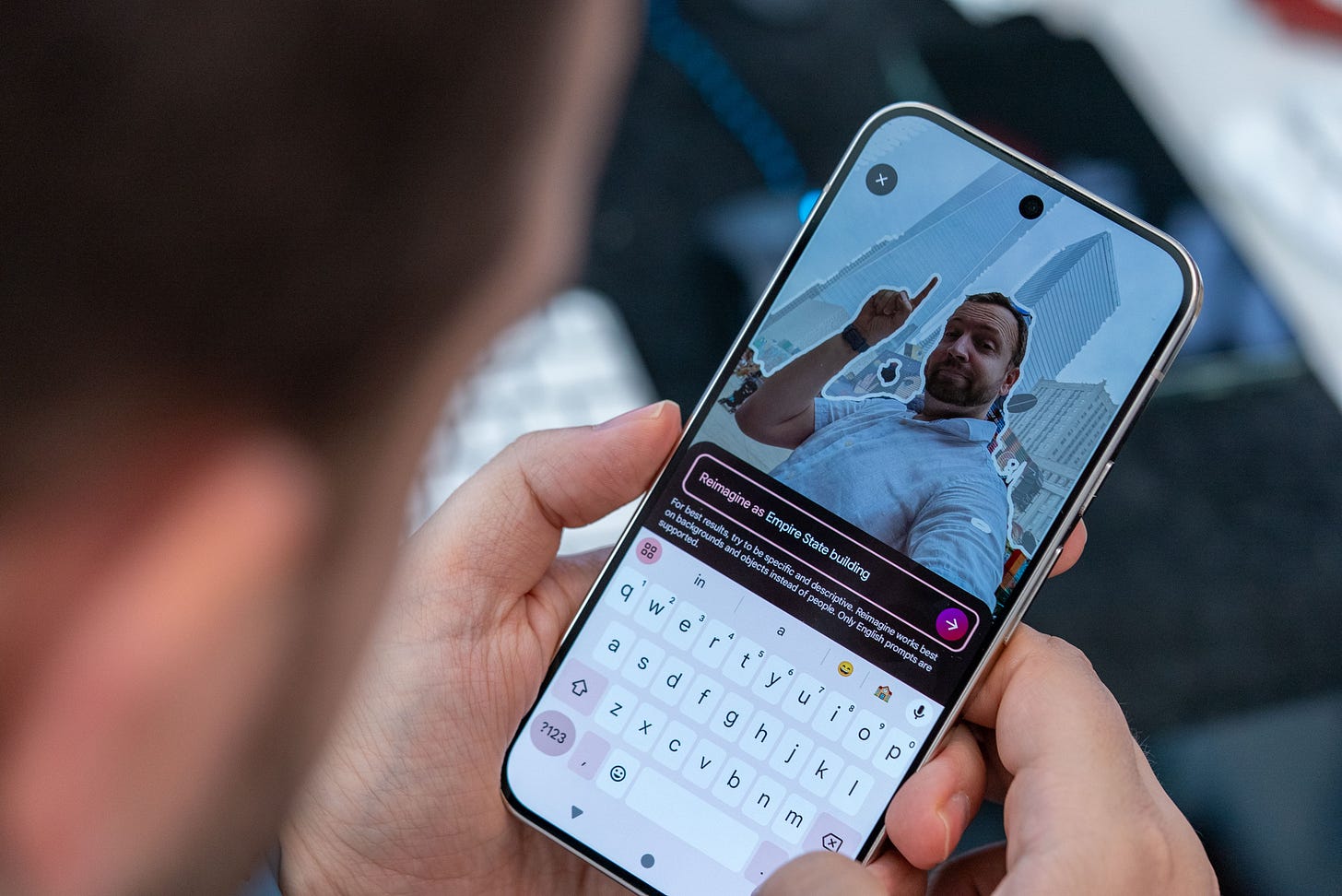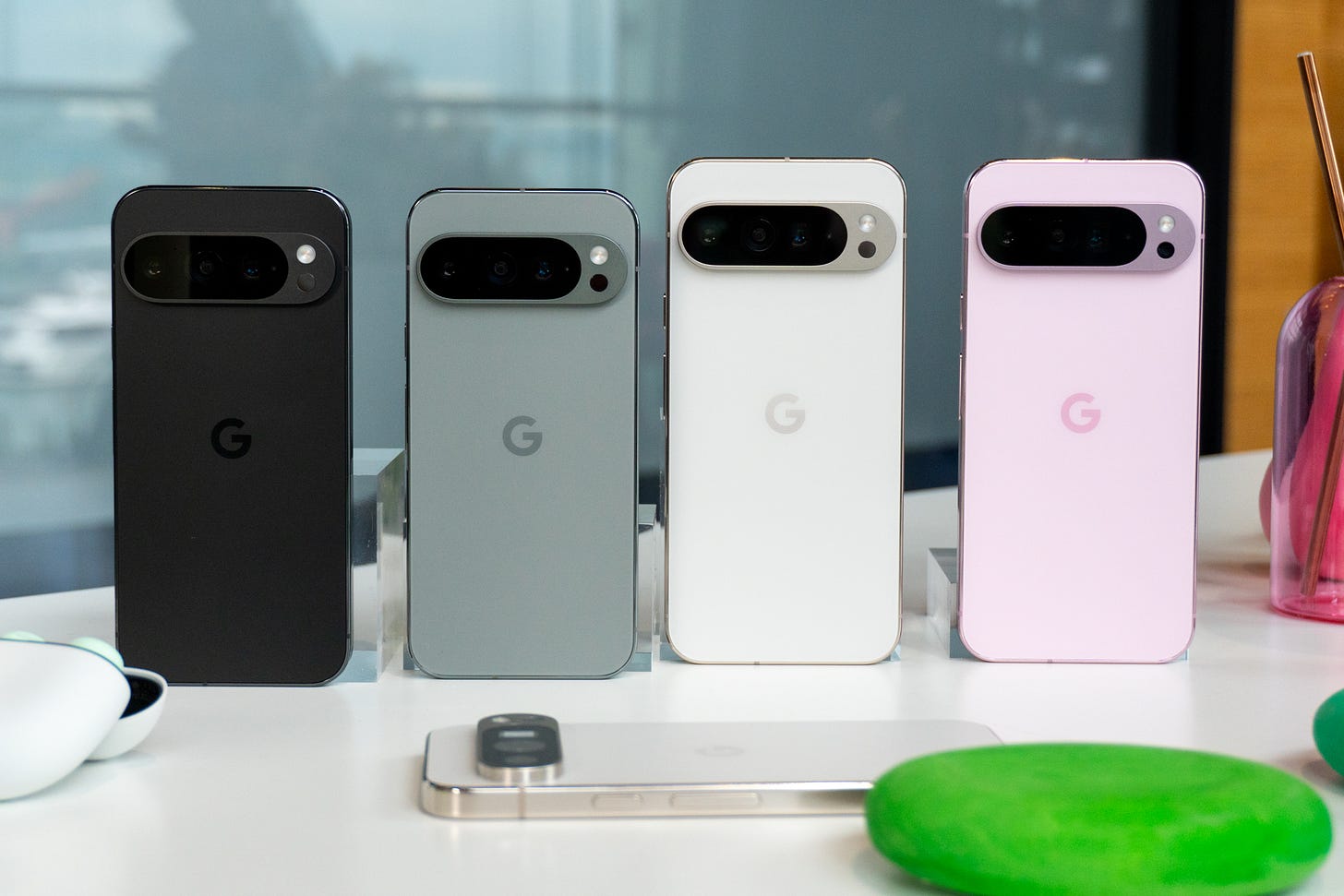
Google Pixel 9 Pro XL review: AI magic in a smartphone camera
The Google Pixel 9 Pro XL will wow you with its AI, including 'Add Me' that will change how you use take group photos

🏆 Review score: 5 out of 5
Pros
✅ 🪄 AI camera magic tricks like ‘Add Me’ exceed expectations
✅ 🤳 42MP selfie camera upgraded for wider, brighter group photos
✅ 💡 Brighter display and slightly thinner bezels than 8 Pro
✅ 🤖 Gemini Advanced is free for a year with Pixel Pro phones
✅ 👇 Much-improved fingerprint sensor accuracy
✅ 🔋 Better battery life and faster charging
Cons
❌ 💰 $100 more for the 9 Pro XL vs last year’s 8 Pro
❌ 🗄️ 128GB of base storage size falls short of rivals
❌ 🧲 No magnetic Qi2 wireless charging – it didn’t make the cut
Pricing & where to buy
💰 Pixel 9 Pro XL: $1,099
💰 Pixel 9 Pro: $999 (coming September 4)
📆 Release date: tomorrow, August 22
I’ve been reviewing Google-branded smartphones every year since the 6 – not the Pixel 6 from three years ago, but the Nexus 6 from ten years ago. I don’t often give out perfect review scores, but this year’s Pixel 9 Pro XL offers the biggest year-over-year leap in performance – especially if you care about the camera.
Why? The Google Pixel 9 Pro XL camera performs AI magic. It delivers AI features that consumers actually care about. I loved testing “Add Me,” a new photo mode that creates an AI composite image, finally allowing photo takers like me to jump into a second pic and nail the all-inclusive perfect family photo or group pic. Come out from behind the 50MP camera – you, too, can be seen.
The Google Pixel 9 Pro XL camera performs AI magic.



I can report that “Add Me” isn’t a gimmick – it actually exceeded my expectations when it worked in good lighting and with consistent poses. I loved being in control of the photos and not having to hand my $1,099 Pixel 9 Pro XL to a stranger. The 42MP selfie camera offers wider, brighter photos, too, but having full-body shots means Add Me is something I can’t live without (more camera samples below).
All of this builds on top of last year’s “Best Take,” which allows me to swap heads among a series of photos, in case I look good in one pic and my friends or family look better in others shots. That photo of my nephew making a silly face in one of our otherwise perfect photos? Google’s got you beat, little man! Families love this AI tool.
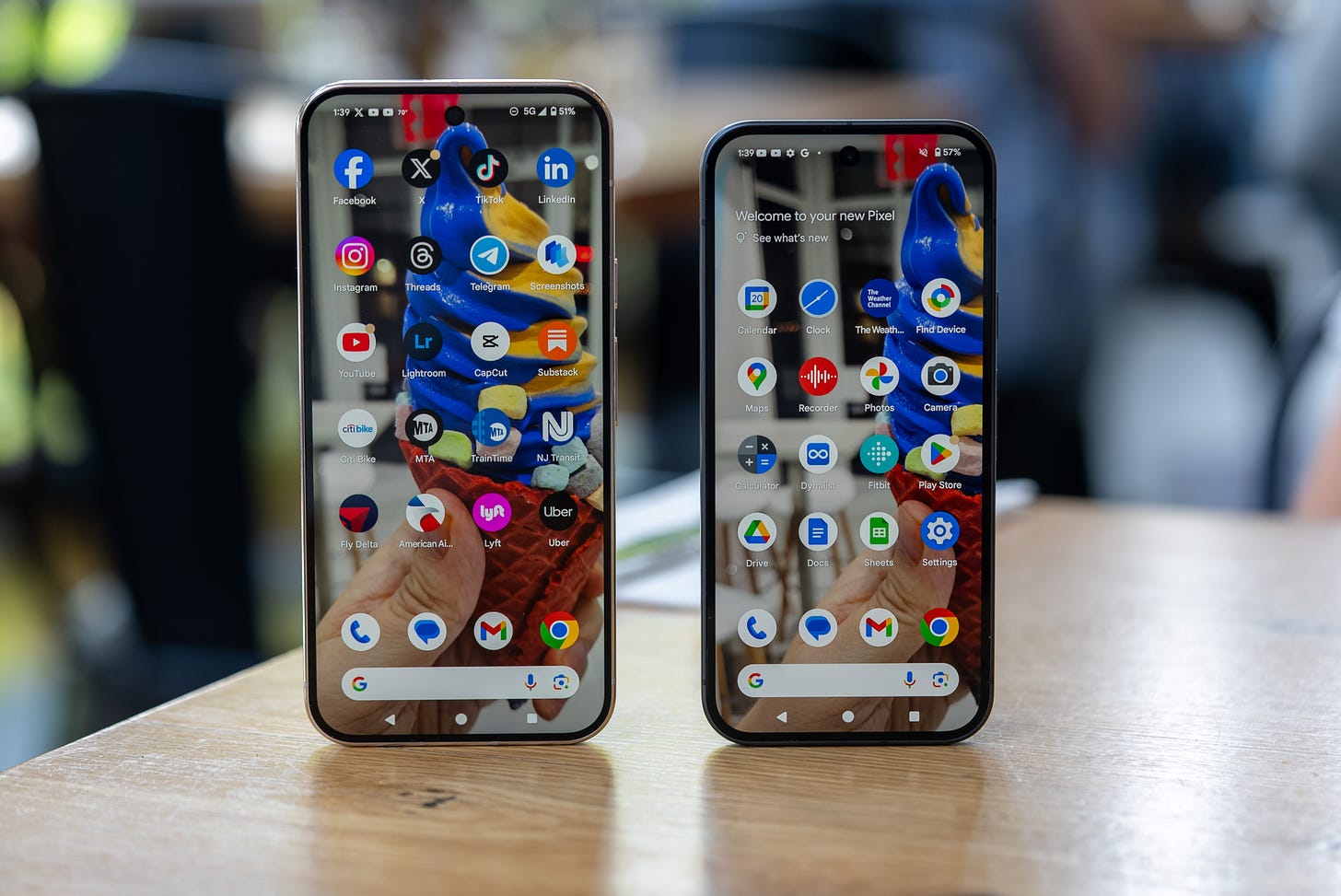
The new Pixel Screenshots app uses AI to help sort and data-mine my “screenshot everything” addiction (14,000 and counting). Again, it’s actually useful AI, not just another clone of ChatGPT-4o – though Gemini AI is out to challenge OpenAI, too.
Google, which leapfrogged Apple’s event by launching in August instead of its usual October, is pushing its Gemini AI features out to consumers before Apple Intelligence even has a chance. And it has an offer Android fans can’t refuse: Gemini Advanced, a $20-a-month subscription, is free for a year with any Pixel 9 Pro phone purchase.
Beyond the camera and AI, the Pixel 9 Pro XL offers other upgrades over last year's Pixel 8 Pro: a brighter display with slightly thinner bezels, better battery life with much faster charging, Satellite SOS, and much-improved fingerprint sensor accuracy (a gripe that caused at least one subscriber of The Shortcut to return his Pixel 8 Pro).


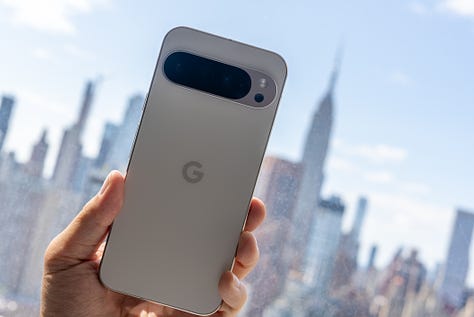
I appreciate the fact that Google’s “Pro” phone finally comes in two sizes with shared specs in the smaller size beyond the non-Pro $799 Pixel 9. If you find smaller screens more comfortable, you, too, can enjoy the fruits of the best Pixel upgrade I’ve tested in years. I’ll have a Google Pixel 9 Pro review and a Google Pixel 9 Pro Fold review closer to their September 4 release dates.
And, of course, I’ll have an iPhone 16 Pro review when Apple launches its next phone. I’m really interested in seeing what Apple brings to the table to rival this Pixel. It won’t be long now. The iPhone 16 release date rumors suggest it’ll launch next month. For testing purposes, I carry my iPhone 15 Pro Max with me daily, along with at least one Android phone (usually the Samsung Galaxy Z Fold 6 or Samsung Galaxy S24 Ultra). However, my eSIM is staying logged into the Pixel 9 Pro XL for now.
The Pixel 9 Pro XL offers AI features you can’t get anywhere else. It’s Google’s best phone in a decade.
I’ve had more fun testing this year’s phone than any other prior Pixel or Nexus. I don’t need the AI features that most other phone manufacturers are pushing right now, like to add a hand-drawn hat into a photo using generative AI. More like generative ayyy-eye-roll. It’s simple: Google has consumer-friendly fixes for real-life problems, especially with its groundbreaking camera. The Pixel 9 Pro XL offers AI features you can’t get anywhere else. It’s Google’s best phone in a decade.
Design
📐 Pro in two sizes. Small hands, rejoice! 6.3-inch and 6.8-inch screens offer the same specs (aside from battery life and charging speeds) whether or not you want a big display. You can have Google’s top Pixel camera without stretching your thumbs or cutting back on specs.
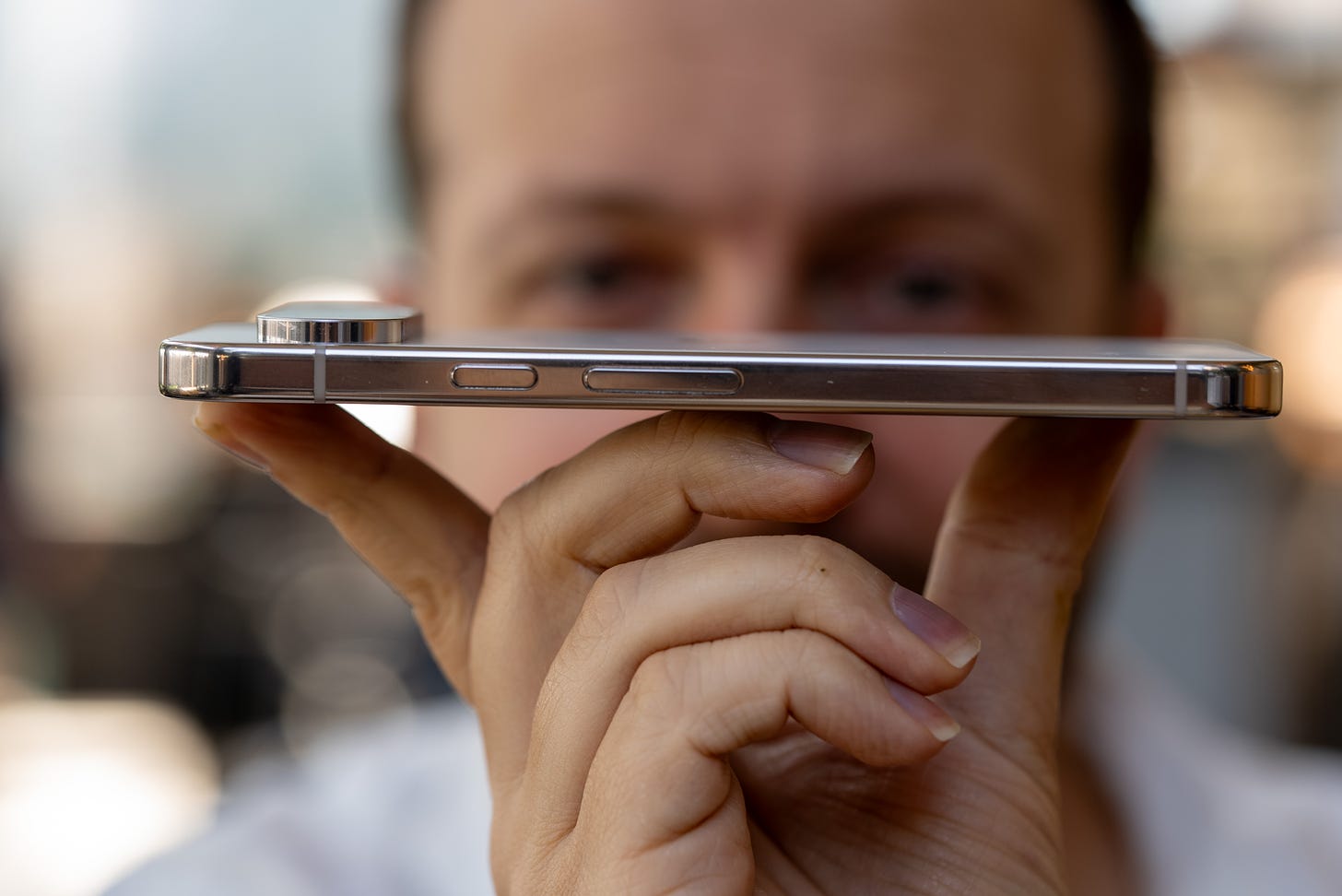
👀 Refined look. I’m a fan of the soft-touch matte finish on the back compared to the glossy finish on the standard Pixel 9. The Pixel 9 Pro XL’s polished metal frame is very shiny in person, thankfully, not as slippery as it looks. The “camera visor,” which no longer stretches the entire width of the Pixel, has also changed. It’s big but worth it, as you’ll see in my photos.
🪨 Strong glass. Corning’s scratch-resistant Gorilla Glass Victus 2 returns, though it was previously only on the Pixel 8 Pro among Google’s phones. So we’re getting it in a smaller size for the first time ever.
🎨 Four colors but no blue. Standard colors Obsidian (black) and Porcelain (white) are here alongside a pop of color: Hazel (gray) and Rose Quartz (light pink). I will miss last year’s Bay Blue color, but at least we’re seeing some fun, non-neutral shades to rival the even better and wider range of Samsung Galaxy S24 Ultra colors.
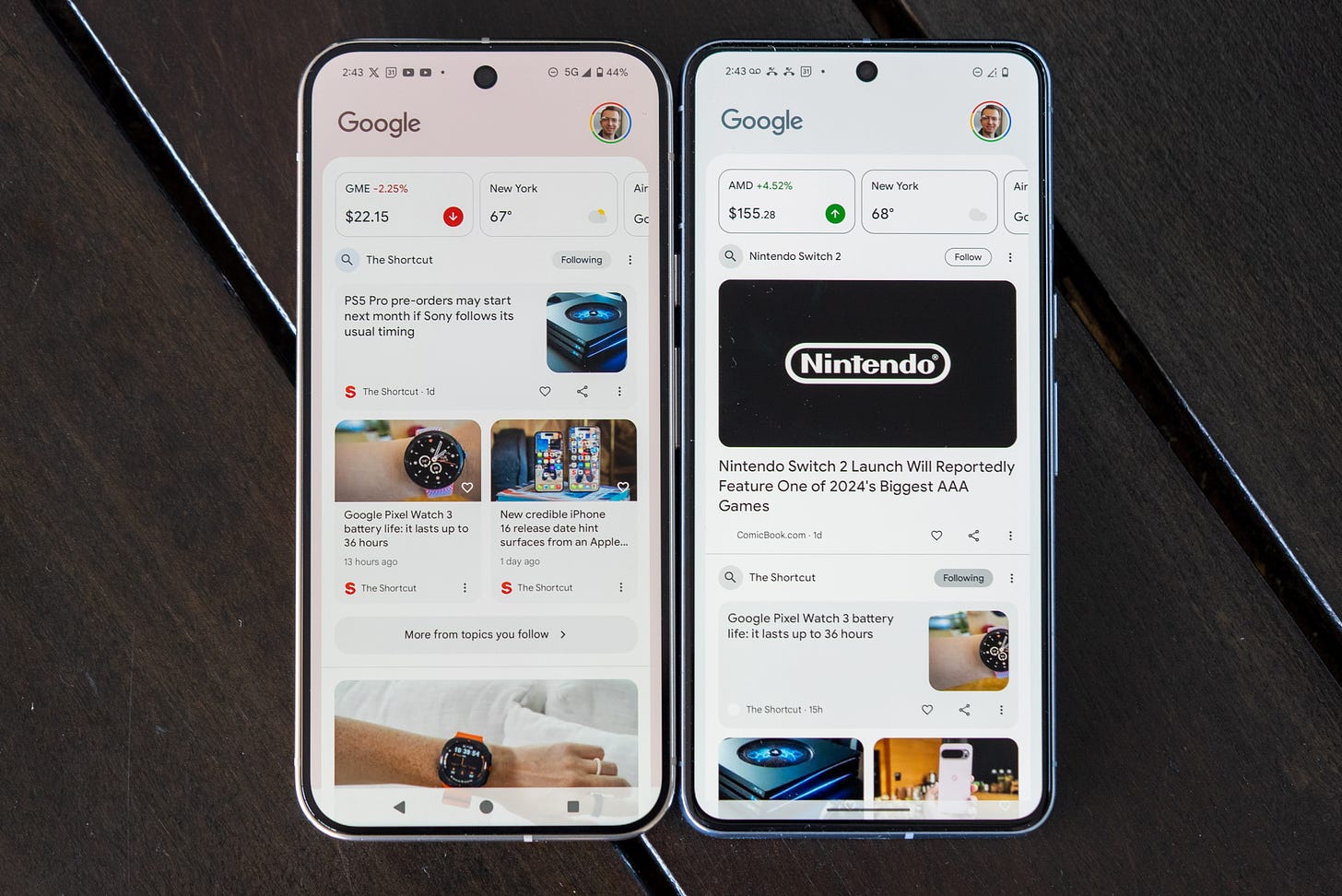
Display
📱15% thinner bezels. It’s a small change, but the border that surrounds the screen has shrunk and is more uniform. If you care about screen-to-body ratios, you’ll enjoy this upgrade. It makes the thicker bezel in our Google Pixel 8a review seem huge.
💡 Extremely bright display. Google’s phone is officially brighter than my iPhone 15 Pro Max when outdoors (3,000 nits vs Apple’s 2,000 nits of peak brightness). When viewing normal HDR content, brightness maxes out at 2,000 nits vs the iPhone’s 1,600 nits. Your move, Apple. Bring on the iPhone 16 Pro.
🏃♂️ 1-120Hz screen refresh rate. Google’s “Super Actua” LPTO OLED display returns with the same adaptive refresh rate we saw last year, but it was limited to the Pixel 8 Pro. Now, it’s included in both sizes, offering a 120Hz refresh rate that can be dialed down to 1Hz automatically when the action isn’t intense, saving battery life.
👇 Ultrasonic under-screen fingerprint sensor. I’ve seen your complaints about the optical fingerprint sensor in Pixel phones. I’m happy to report that Google has ditched that tech for an ultrasonic fingerprint sensor that’s faster and more accurate.
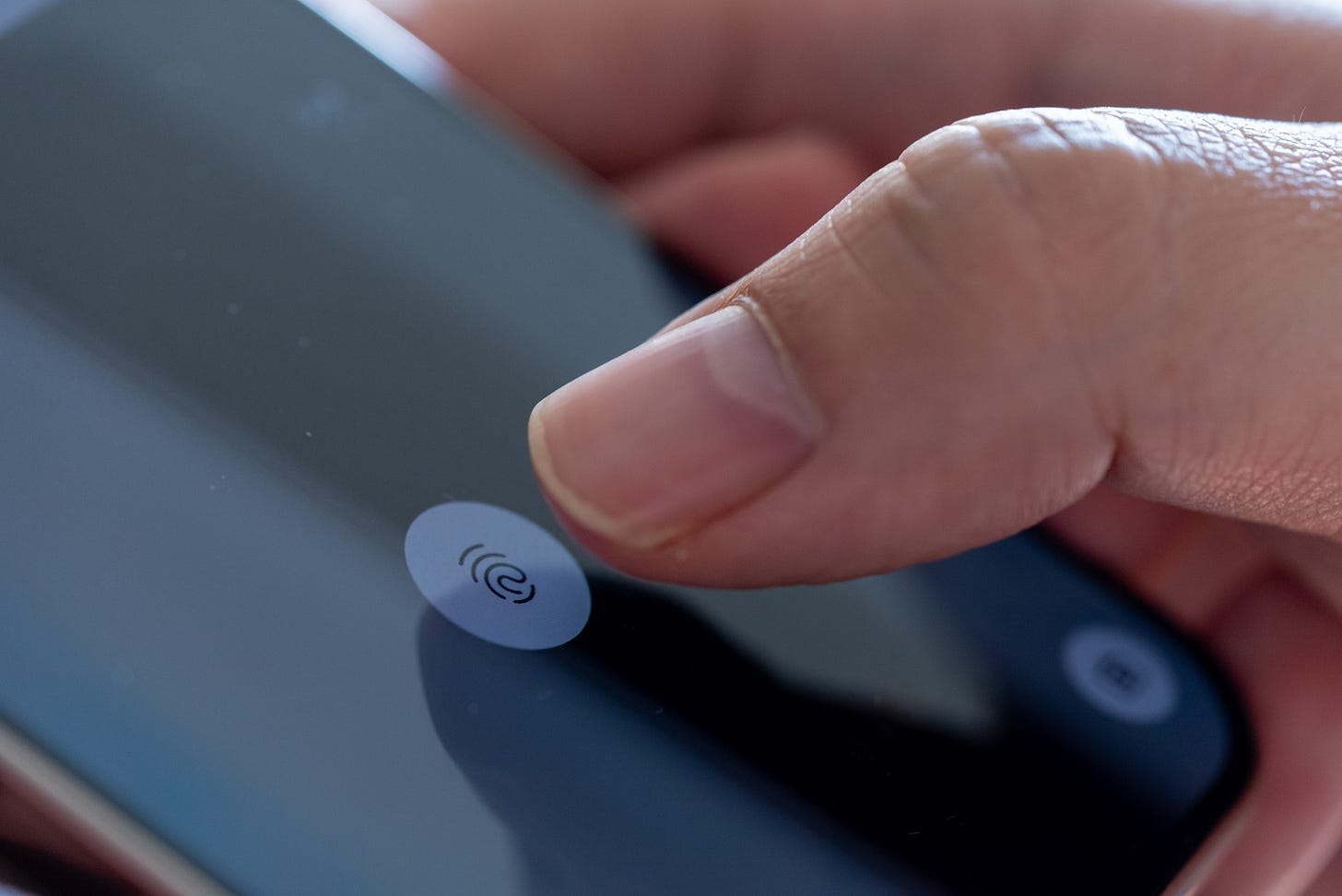
Specs and AI
📶 5G, no upcharge. Something I spotted in my review last year: a “special” Pixel 8 with Verizon’s mmWave 5G that cost $50 more than the base sub6 5G used by other US carriers. Now there’s no split: mmWave + sub6 are both here for the same price.
🛜 WiFi 7 upgrade. Have a WiFi 7 router? Google’s latest phone steps up this spec from WiFi 6e seen in last year’s phones.
If you’re behind Apple on value, that’s really bad.
🐏 RAM for AI. 16GB of RAM (up from 12GB) is designed for AI. Previously, extra RAM in phones was a snake oil specs boast. But we’re starting to see AI chew up memory – see the strict RAM-reliant Apple Intelligence compatibility list for more on that.
🗄️ 128GB to 1TB. Google’s Pro phones start at 128GB, weaker than expected given the price increase. To compare: Samsung Galaxy S24 Ultra, S24+, and iPhone 15 Pro Max all start at 256GB. You need to spend $100 more for 256GB here. If you’re behind Apple on value, that’s really bad.
⚙️ Tensor G4 chip. Google’s chip offers 20% faster browsing and 17% faster app launches. It won’t compete with Qualcomm or Apple on pure speed. Google notes that its chip is designed for AI more than any specific benchmark.
🤖 Gemini Live’s debut. Google’s Gemini Nano with multimodality and conversational Gemini Live enables the Pixel 9 Pro XL to understand things in context – text, images, audio, and speech, and then act on that within Google’s software products. It works when I ask it most questions, but it’s still prone to errors, just like ChatGPT.
🥕 Better than Rabbit R1. Gemini reminds me of what I wanted when I reviewed the Rabbit R1, which was supposed to be a Large Action Model (LAM). This AI executes on that idea but focuses on working across Google’s vast suite of services.
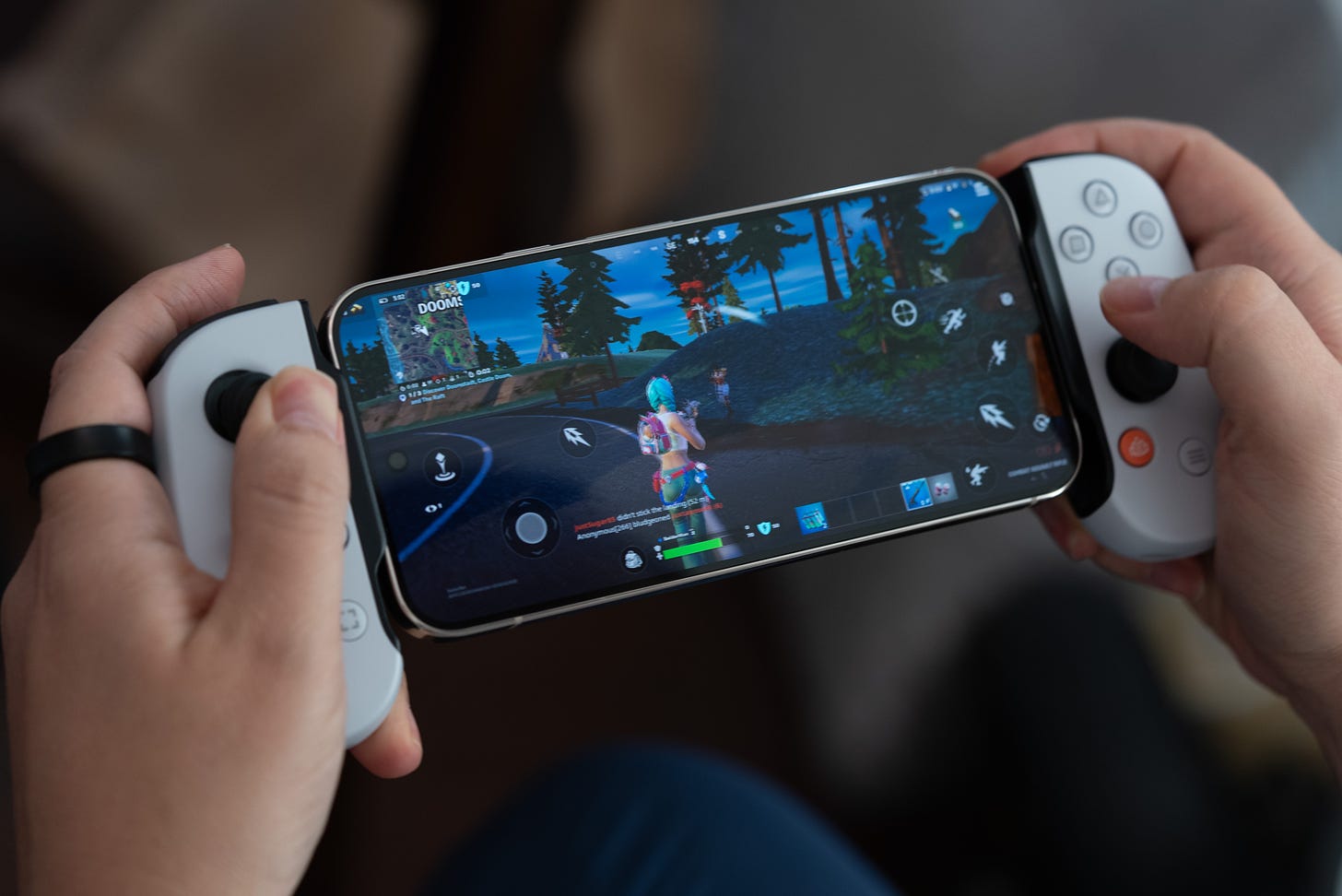
🎮 Gaming performance. Tensor chips have struggled to keep up with Snapdragon 8 Gen 3 phones when gaming (not to mention Apple iPhones). I was able to hit a fairly steady 120fps on Call of Duty Mobile with fewer dropped frames than last year, but I got better, more consistent performance with both Samsung and iPhone when trying more intense open-world 3D games like Genshin Impact.
🥶 Vapor chamber. Notably, Google redesigned the cooling of the Pixel 9 Pro, so multi-tasking, AI, and gaming while charging didn’t overheat this phone. The extra space may be why we see charge charging speeds on the Google Pixel 9 Pro XL only.
📡 Satelite SOS. Catching up with Apple’s iPhone SOS feature, Google finally offers a way to make a connection in an emergency. Both Qualcomm and MediaTek unveiled plans for this, but this is the first time we’ve seen it in a Google-owned smartphone.
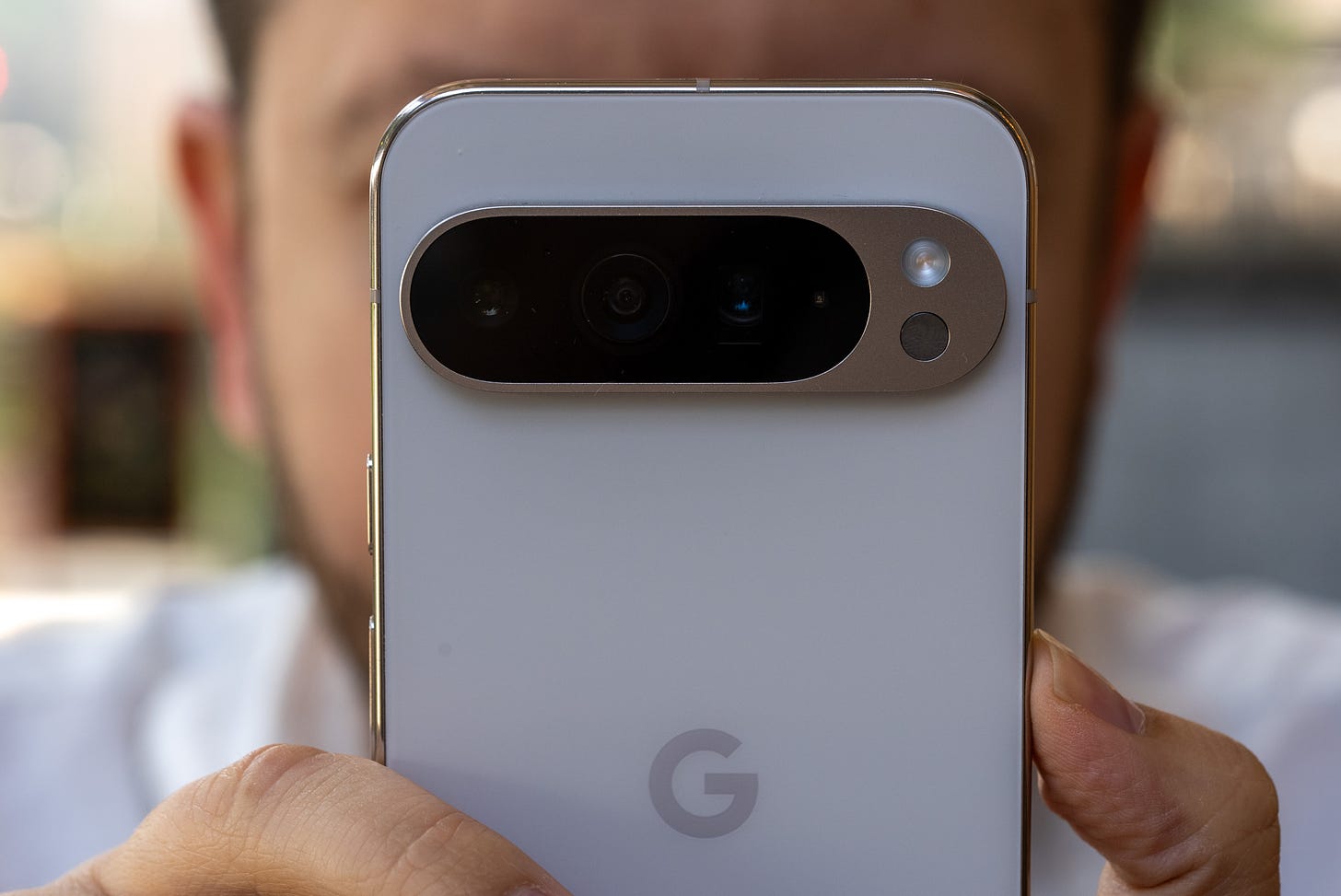
Cameras
📸 50MP main, 48MP ultrawide. The camera megapixels and sensor sizes are the same as those of the Pixel 8 Pro, but Google says it rebuilt the HDR pipeline. This is most noticeable in my panoramic shots of NYC.

🔭 48MP telephoto. I also noticed clearer SuperRes 5x telephoto photos (up to 30x digital zoom). Even though the telephoto camera specs haven’t changed since the 8 Pro, Google’s post-processing software has improved.




🤳 103° wide selfies. I love Google Pixel’s wide 103° field of view selfie camera. It reminds me of my favorite (for its time), the LG V10, which had a 120° field of view. It captures everyone and everything in your group shots, telling a fuller story.
Here are a few comparison shots: Notice I can fit tall, iconic buildings in with wider selfies without having to back up.






🤩 I’m ready for my 42MP selfie, Mr. Demille. This is a big upgrade over last year’s 10.5MP front camera, offering 30% more light sensitivity. The main cameras didn’t change a lot, but the front one did, and I’m noticing fewer blown-out highlights.

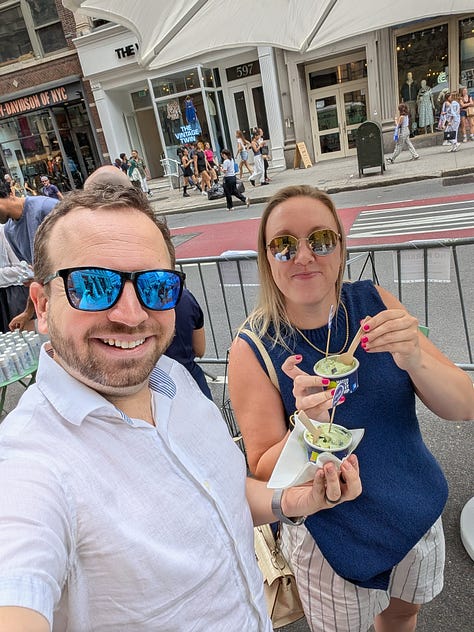

AI camera tricks
🤗 ‘Add Me’ inserts you in pics with AI. The camera taker and subject can swap roles and appear together in a composite shot, which is extremely handy for moms and dads behind the camera who can’t always get the entire family in a vacation pic. Google uses 15 on-device AI models to pull off its latest photo magic trick.
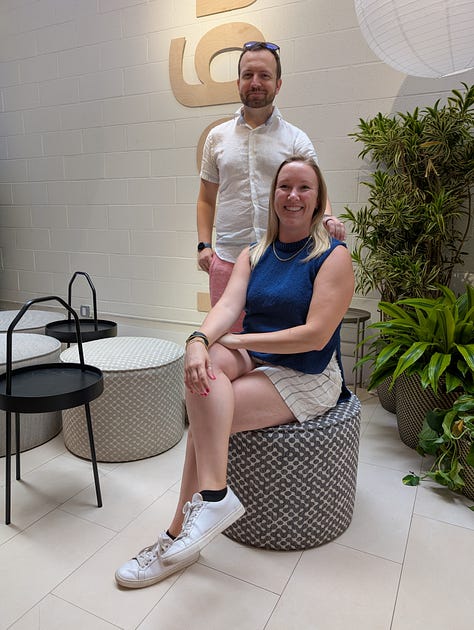

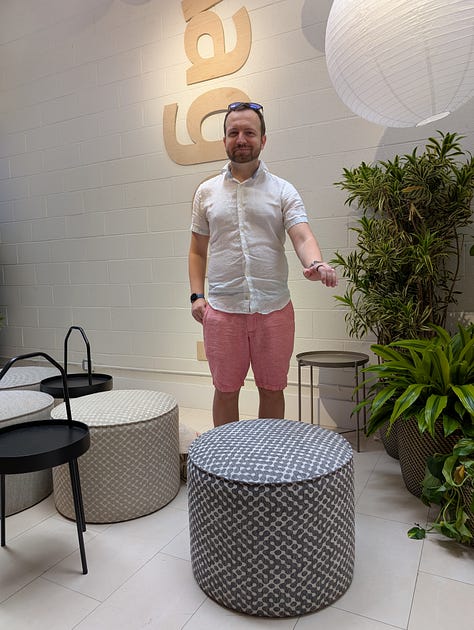
🤯 ‘Add me’ is mind-blowing – when it works. I can report that it actually works as intended in most cases, especially with enough light. It leaves a ghosting effect or occasionally clips certain elements, usually if it’s too dark or you strike a pose that conflicts with another overlapping subject.

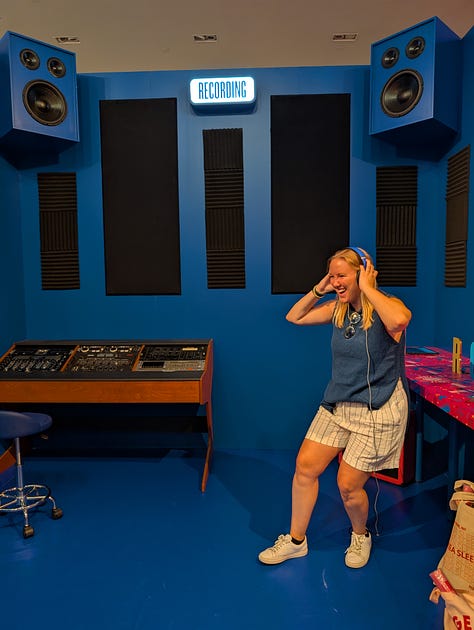

😈 ‘Add Me’ is fun – in the right hands. There’s a chance that an AI feature like Add Me can be used by bad actors to manipulate photos. This is outside of its intended use – to make group shots more inclusive and keep your phone out of the hands of strangers. I did have a little fun taking advantage of being in my own photo twice.



🖼️ ‘Auto Frame’ in Magic Editor. Ever wish you could zoom out of a photo? This AI editing tool lets you simulate that by recomposing the shot with a new border that’s “based on known photo techniques.” I found it works OK but fails if you’re trying to expand upon buildings or copyrighted iconography.
That last “Add Me” photo cut off my arm. Auto Frame isn’t perfect, but this is what it looked like when this new Magic Editor tool got to work:

🪄 Reimagine in Magic Editor. I prompted changes to a photo with “Reimagine as… him on a Safari,” and sure enough, Kevin Lee was transported from NYC to the wilds of Africa. I find this sort of AI to be a gimmick, but it can be a fun party trick.
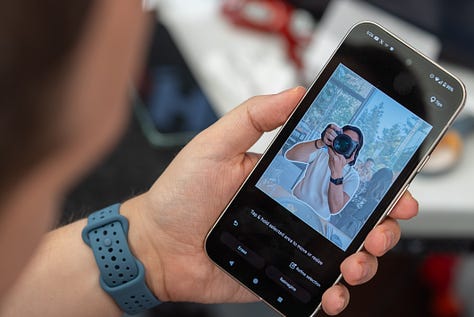
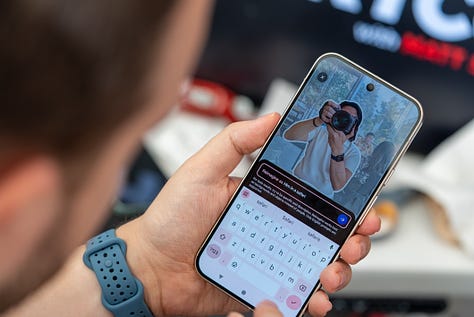
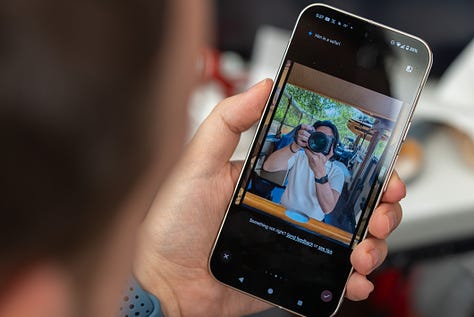
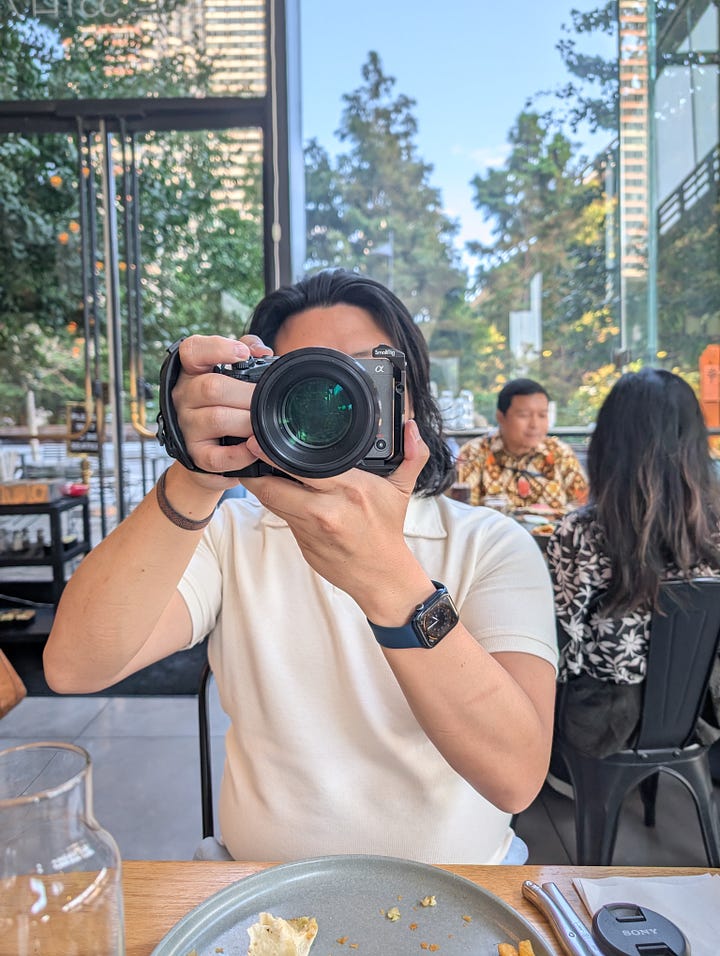

🤪😃🙄 Best Take returns. This AI head-swapping feature premiered in the entire Pixel 8 series, as I noted in our Pixel 8a review (Google isn’t holding back on some of its AI when launching cheaper advice), and I need to highlight it again. No one else has copied this feature, and it remains priceless for friends and families trying to get the perfect group photo.
📹 Video Boost rivals iPhone. Google put a lot of emphasis on its video upgrade for one reason: Apple’s video capabilities remain unbeatable. The Pixel 9 Pro series does get closer by offering 2x as fast video rendering as the Pixel 8 Pro and HDR+ across all zoom levels, from 5x optical to 20x. It automatically uploaded my videos and applied video boost, making the process seamless. I still prefer the consistency of the video out of my iPhone (entirely on-device) and Samsung’s best-in-class camera UI.
🎥 8K upscaling. Video recording remains 4K, but the Pixel 9 Pro XL can simulate 8K and allow me to pull out 30MP HDR stills from Google’s AI-upscaled videos. It’s impressive, but it takes a trained eye to see the differences on a smartphone.

Battery
🔋 24+ hour battery. Google has more than all-day battery life for the first time, at least on the larger Pixel Pro XL. This is thanks to its 5,060mAh capacity (up from 5,050mAh) and Tensor G4 chipset efficiency.
🪫 100-hour Extreme Battery Saver. This mode will get you through a rough patch by limiting your phone usage to core apps like the phone, camera, text messages, and the clock (so your alarms won’t turn off). Everything else will be in grayscale.
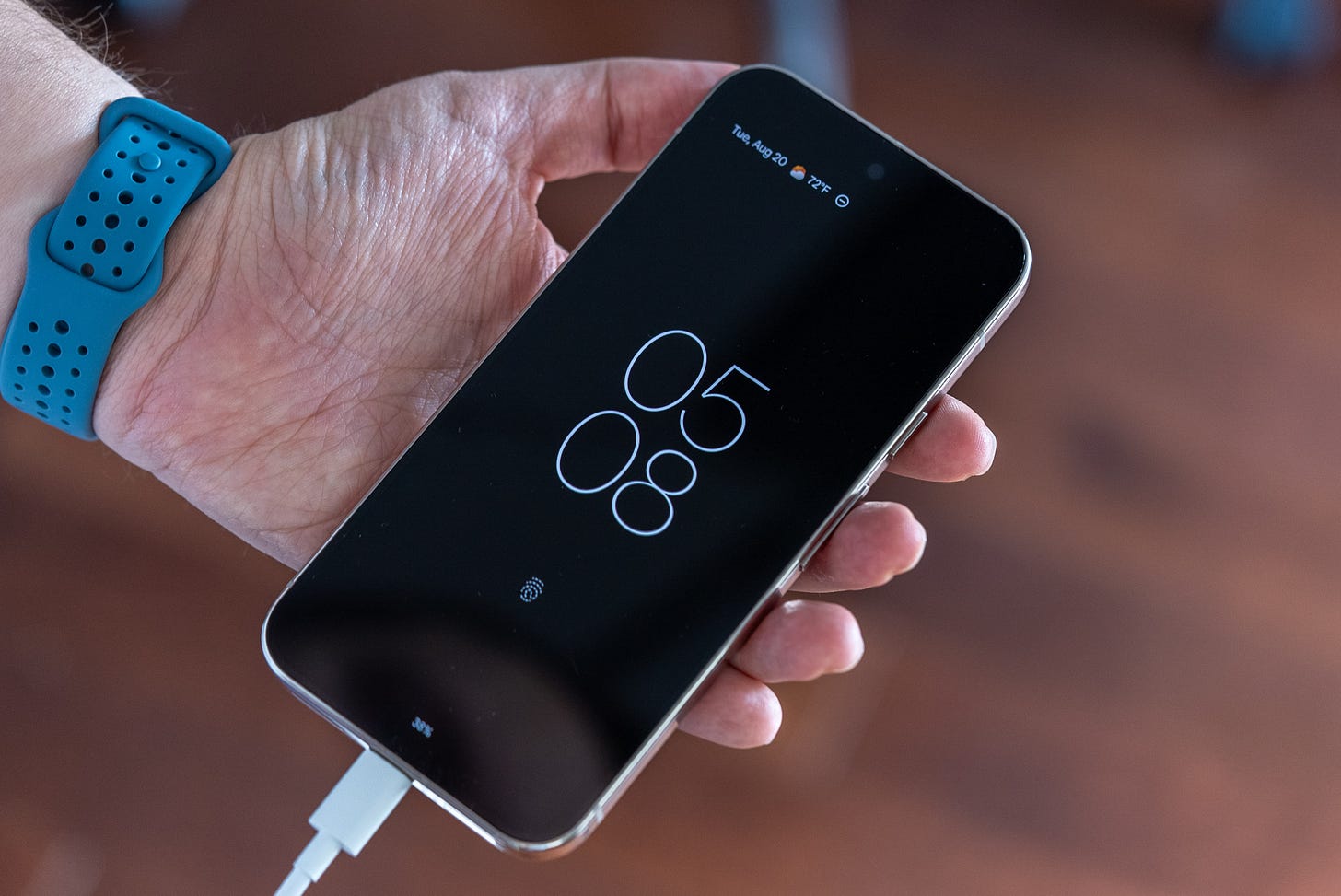
⚡ 70% charge in 30 mins. You can get Google’s fastest charging speeds via a 45W charger. Use a laptop charger if you have one because going to 70% in just a half hour is something that tends to only come from phones out of China.
Pixel 9 Pro XL: 5,060mAh
Pixel 9 Pro: 4,700mAh
Pixel 9: 4,700mAh
Pixel 8 Pro: 5,050mAh
🆚 Only in the Pixel 9 Pro XL. The Pixel 9 Pro (and Pixel 9) can charge 55% in 30 minutes with a 45W charger, and they have smaller batteries, so getting to this level is something for the Pixel 9 Pro XL. It may be the best reason to buy this phone.
Pixel 9 Pro XL: 70% in 30 mins.
Pixel 9 Pro: 55% in 30 mins.
Pixel 9: 55% in 30 mins.
🧲 No magnetic Qi2 charging. The Google Pixel 9 series doesn’t feature something I’ve enjoyed on the iPhones: MagSafe. The Qi2 specification is out there, but we won’t see any of this year’s Android phones cling to wireless chargers. This is a miss. During my testing, I didn’t properly align this phone on my Mophie 3-in-1 Travel Charger, and I woke up with a nearly dead battery the next day. Consider this a casualty of the Pixel’s rushed 10-month upgrade cycle.
Pricing
💸 Sneaky $100 price increase. At first glance, the 6.8-inch Google Pixel Pro 9 XL seems like a new tier that didn’t exist before, so its higher $1,099 price makes sense. But if you’re upgrading from last year’s $999 6.7-inch Google Pixel 8 Pro, you’re paying $100 more. Really, the 6.3-inch Google Pixel Pro at $999 is the new model – don’t let the name fool you.
🆓 🤖 Gemini AI for free. A full year of Gemini Advanced, Google’s AI answer to ChatGPT-4o, comes with the Pixel 9 Pro and 9 Pro XL (as well as the Pixel 9 Pro Fold). That’s a $20-a-month value ($240 a year).

Should I buy the Google Pixel 9 Pro XL?
Yes, if…
✅ You want Google’s best cameras, including wider 42MP selfies
✅ You value AI magic tricks like ‘Add Me’ and Pixel Screenshots
✅ You’re already paying for AI like Gemini Advanced (a $240 value)
✅ You hated the fingerprint sensors in prior Pixel phones (it’s fixed)
✅ You want 24+ hour battery life and fast charging (best on the XL)
No, if…
❌ You don’t do group pics or selfies where Pixel 9 Pro XL excels (get S24 Ultra)
❌ You want even more screen (get Pixel Fold 9 Pro or Galaxy Fold 6)
❌ You think a $100 price increase and stingy base 128GB is a rip (get S24 Ultra)
❌ You’re a gamer who desires performance (get Snapdragon 8 Gen 3 phones)
❌ You’ll get shamed for leaving iMessage (stick with an iPhone 15)
❌ You’re bummed about no MagSafe-like Qi2 (wait for Google Pixel 10 XL)






